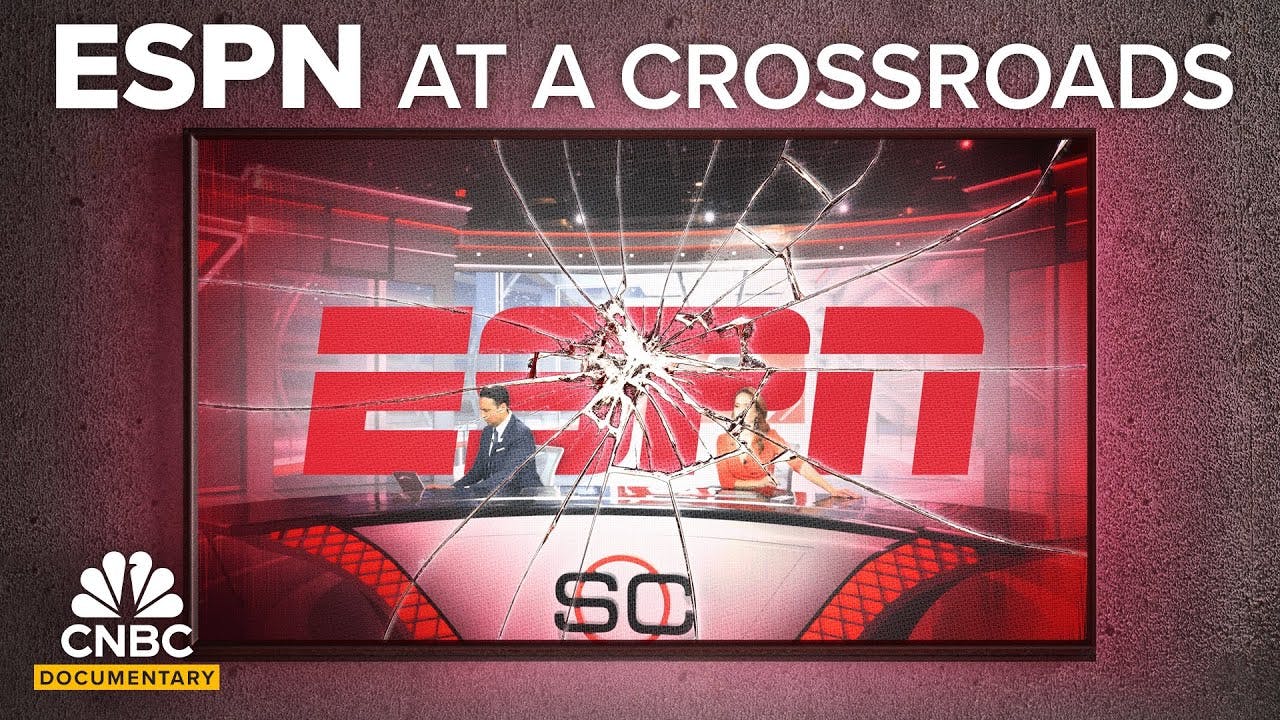How ESPN Will Survive The Decimation Of Cable TV
()

Intro (00:00:00)
- ESPN has been the most-watched basic cable network for 32 consecutive years.
- The media landscape is changing rapidly, with 40 million US households canceling traditional cable from 2013 to 2023.
- ESPN relies on cable subscription fees for 62% of its revenue.
- Streaming services like Amazon, YouTube, and Apple are investing heavily in live sports, challenging ESPN's dominance.
- Disney, ESPN's parent company, is concerned about the transition from cable to streaming.
- Former ESPN president John Skipper and ex-Disney CEO Bob Chapek acknowledge the challenges in transitioning from cable to streaming.
- ESPN faces competition from tech companies with deeper pockets.
- ESPN's estimated valuation in 2014 was over $50 billion.
- Analysts now value ESPN at about half of its 2014 valuation.
- ESPN's current business model is no longer sustainable.
- ESPN is exploring new strategies to ensure its relevance in the changing media landscape.
- The future of ESPN is less profitable compared to its peak.
ESPN’s streaming plan (00:02:26)
- Despite its profitability, with $2.9 billion in operating income and $16 billion in revenue in fiscal 2022, ESPN's growth is slowing down, with revenue increasing by only 1% in the first quarter of fiscal 2024 compared to the previous year.
- ESPN's traditional business model of charging cable companies for the right to include the network in their bundles is becoming unsustainable as cable TV declines.
- ESPN is adapting to the changing landscape by launching its own streaming services, including a joint venture with Fox and Warner Bros. Discovery, and its own flagship streaming service in 2025.
- ESPN is facing challenges due to the decline in cable TV subscriptions and needs more cash to keep paying for popular live sports rights.
- ESPN is in talks with potential strategic partners, including the NBA and NFL, for marketing and additional content, and may offer a small stake in its business to partners.
- Traditional TV ratings for popular live sports are actually rising.
Rising cost of sports (00:09:00)
- Despite changes in the media landscape, sports fans remain loyal, leading to higher advertising revenue and competition among media companies for sports rights, driving up their prices.
- ESPN's exclusive rights to popular events like Monday Night Football and the College Football Playoffs have proven highly profitable, with ratings consistently increasing.
- To maintain its competitive edge, ESPN employs a strategy of securing long-term rights to live sports events, ensuring a steady stream of valuable content.
- ESPN is adapting to changing audience preferences by offering alternative broadcasts like the Manningcast and considering dropping expensive studio talent and secondary/tertiary sports to adapt to the changing landscape.
- The company remains committed to live sports as its core business but recognizes the importance of storytelling and content discovery in a direct-to-consumer world.
Mounting competition (00:16:15)
- New buyers like Netflix, Google, Amazon, and Apple are competing with ESPN for sports rights.
- These companies have much bigger balance sheets than Disney, which owns ESPN.
- It is unclear if these tech companies will outbid ESPN for future live sports rights.
- Linear TV is in accelerating secular decline, and everyone is looking for an exit strategy.
- The appetite from the tech companies for sports rights is not clear.
- Google's YouTube spends $2 billion each year for NFL Sunday Ticket.
- Amazon is paying $1 billion per year for Thursday Night Football.
- Spending big money on live sports helps increase Prime subscriptions.
- Amazon had more prime signups after going live with its first Thursday Night Football game than during any other one day period.
- Ratings were up 24% in year two.
- Amazon is building out its advertising business on Prime Live.
- NFL games could be an essential piece of the puzzle for Amazon's advertising business.
- Amazon is uniquely positioned with its data and the fact that it's a connected experience.
- Prime video will exclusively stream its first NFL playoff game in 2024.
- Amazon has also acquired local rights for Major League Baseball and the WNBA to hedge against tech overrunning ESPN with cash.
- Bob Chapek believes ESPN can transform itself into a digital portal, a centralized location for all sports fans to find the games they want to watch.
- Streaming is all about satisfying the customers with more personalized and more customized type experience.
- ESPN is well-positioned to play this role as the market leader in sports.
ESPN’s future (00:20:08)
- ESPN will debut new streaming offerings while managing the decline of cable TV.
- Disney is committed to keeping ESPN as part of Disney.
- If ESPN's revenue declines and streaming can't make up the difference, Disney may need to sell or spin off ESPN.
- ESPN and Disney have positioned themselves to have optionality.
- Big tech companies could decide to become leaders in sports, potentially acquiring ESPN.
- Disney may continue to own ESPN despite arguments that it should be sold.
- If ESPN is spun off or sold, Disney will lose the billions in cash it generates.
- ESPN has a brand synonymous with the highest quality sports, which is an advantage over competitors.
- ESPN's content is king, and it is a critical part of Disney's portfolio.
- ESPN may not be able to create a better business model in a direct-to-consumer world.
- Streaming services have overloaded consumers with content.
- With TikTok, Instagram, and YouTube, people have more entertainment options than ever.
- Sports are still watched live together and are the last vestige of the American monoculture.
- Fans want a place to follow their favorite teams and players 24/7.
- Disney's job is to ensure that place remains ESPN.